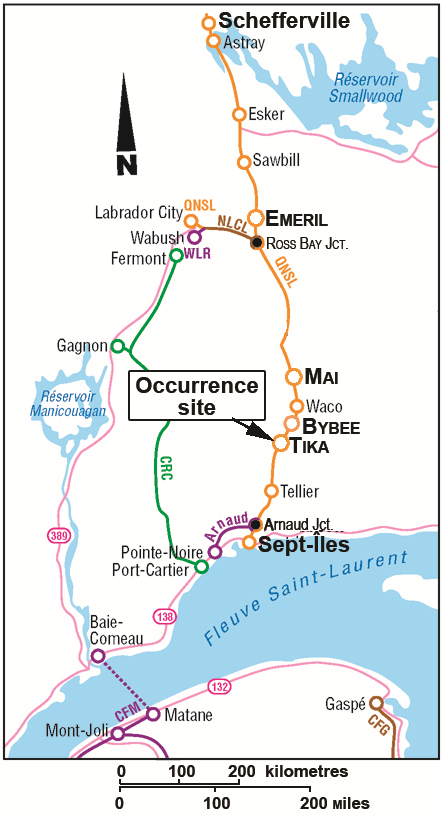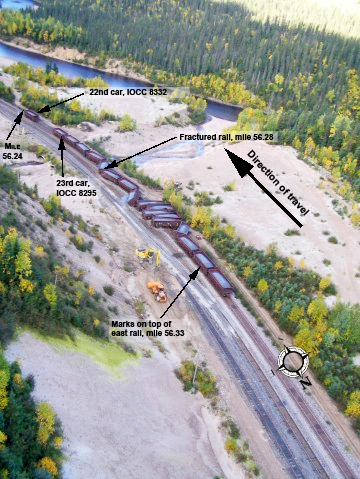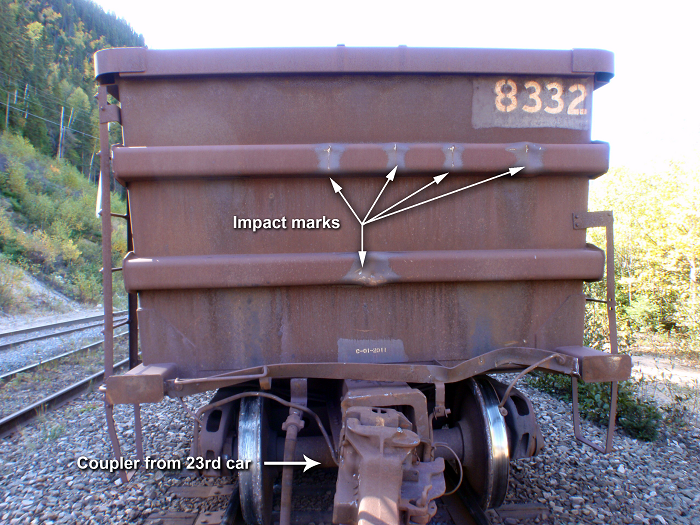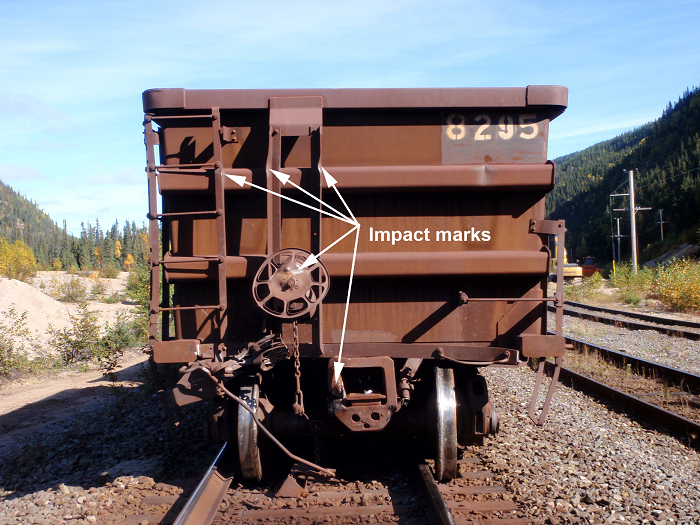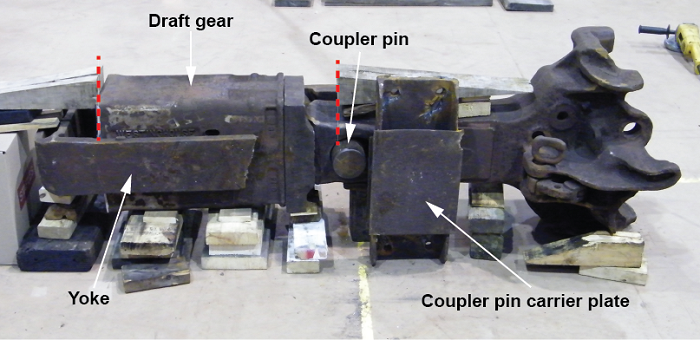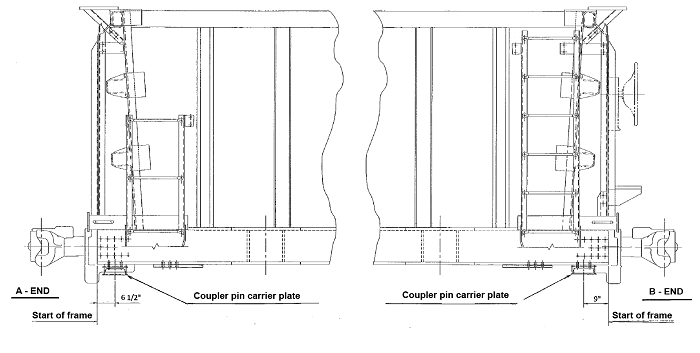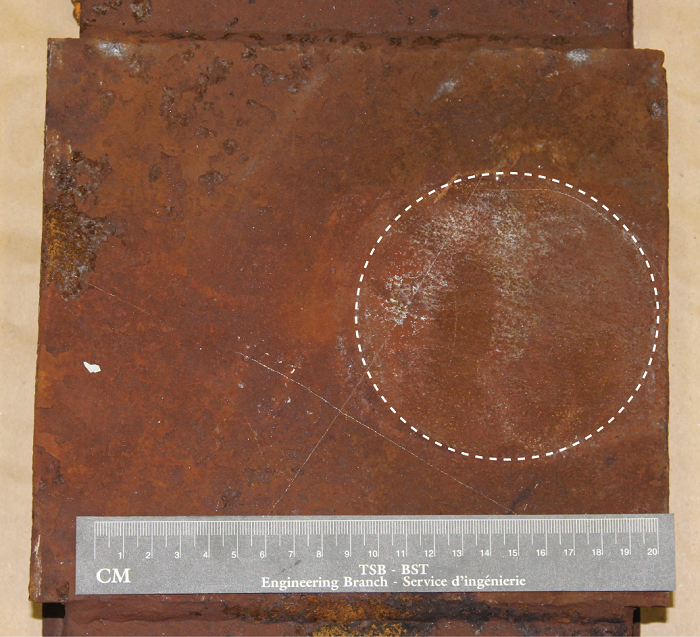Main-track derailment
Quebec North Shore and Labrador Railway
Freight train PL 485
Mile 56.33, Wacouna Subdivision
near Tika, Quebec
The Transportation Safety Board of Canada (TSB) investigated this occurrence for the purpose of advancing transportation safety. It is not the function of the Board to assign fault or determine civil or criminal liability. This report is not created for use in the context of legal, disciplinary or other proceedings. See Ownership and use of content. Masculine pronouns and position titles may be used to signify all genders to comply with the Canadian Transportation Accident Investigation and Safety Board Act (S.C. 1989, c. 3).
Summary
At approximately 0615 Eastern Daylight Time on 26 September 2011, Quebec North Shore and Labrador Railway train PL 485 derailed 17 loaded ore cars at Mile 56.33 of the Wacouna Subdivision near Tika, Quebec. About 450 feet of main track was damaged and about 200 feet of the siding track was damaged. There were no injuries and no permanent environmental damage.
Ce rapport est également disponible en français.
Factual information
The accident
On 26 September 2011, Quebec North Shore and Labrador Railway (QNS&L) ore train PL 485 (the train) left Mai, Quebec, proceeding southward to Sept-Îles, Quebec. The train consisted of 3 locomotives (2 at the head end and 1 about two-thirds back) and 241 gondola cars loaded with iron ore. It weighed about 29 350 tons and was approximately 8650 feet long. Only one person was on board the train; a locomotive engineer who was familiar with the territory. The engineer met fitness and rest standards and was qualified for the position.
When the train left Mai, a brake test was performed. A pull-by inspection was conducted at Bybee and no defects were reported. At Mile 59.30, the train passed over a hot box and dragging equipment detector; no alarm sounded.
At approximately 0615,Footnote 1 as the train was proceeding in the vicinity of the Tika Station (Figure 1), a train-initiated undesired emergency brake application occurred when the locomotive was at Mile 56.25. The lead locomotive came to rest at Mile 56.07. After taking the appropriate emergency measures, the locomotive engineer determined that 17 cars (22nd to 38th) had derailed.
It was mostly cloudy and the temperature was 13°C.
Site examination
The derailment area covered about 450 feet (Photo 1). Derailed equipment included 17 gondola cars loaded with iron ore.
The 22nd car from the head end, IOCC 8332, was the first to derail. It remained coupled to the head end of the train while the other derailed cars separated from the train and came to rest about 250 feet north. All cars remained upright except for the 30th car, which came to rest at a 45° angle on the east side of the track. The 22nd car derailed its trailing truck. The next 7 cars, from the 23rd to the 29th, derailed parallel to the track while the next 6 cars, from the 31st to the 36th, jackknifed. The 38th car derailed its lead truck only.
All derailed equipment was examined. The coupler on the 23rd car (IOCC 8295) detached and remained coupled to the 22nd car. The coupler pin and coupling lever were found between the rails at Mile 57.06 and Mile 56.40 respectively. There were impact marks at the ends of these 2 cars and on the west side of the trailing axle and frame of the 23rd car (photos 2 and 3).
About 450 feet of main track was damaged, 240 feet of which was destroyed, and about 200 feet of the siding track was damaged. Wheel marks were observed on the top of the east rail at Mile 56.33, about 50 feet from where track damage began.
Track information
The Wacouna Subdivision consists of a single main track linking the Sept-Îles Yard (Mile 0.00) to Emeril Junction (Mile 225.30). Train movements are governed by the Centralized Traffic Control System authorized by the Canadian Rail Operating Rules, and supervised by a rail traffic controller located in Sept-Îles.
According to the Railway Track Safety Rules approved by Transport Canada, the track is rated Class 3. Maximum allowable speed in the occurrence area is 30 mph. Traffic consists of 9 trains per day (ore, freight, and passenger), for an annual tonnage of close to 28 million gross tons.
In the occurrence area, the track is made up of 136-pound continuous welded rail on 18-inch, double-shouldered tie plates in curved track and 14-inch, double-shouldered tie plates in tangent portions. There are 6 spikes per tie and approximately 3250 hardwood ties per mile. Ties are box-anchored every second tie. Ballast is about 12 inches thick, with shoulders between 12 and 16 inches. It is mainly made up of 1.5- to 3-inch-diameter crushed rock. In the direction of travel, there is a slight grade and a 630-foot-long, 4° right-hand curve, followed by a 250 foot long tangent portion and then a 680-foot-long, 4° left-hand curve (between Mile 56.34 and Mile 56.21).
The track underwent regular inspections and no defect had been reported in the derailment area. The last visual inspection had been done 22 September 2011. The last geometry car test had been done on 16 May 2011 and the last rail defect detector test had been done on 14 July 2011.
Car IOCC 8295 coupling device examination
The coupling device at the B end of car IOCC 8295 had a type F coupler (code F70CE) attached to the yoke with a vertical coupler pin supported by a horizontal carrier plate (Photo 4). TSB Laboratory examination of the coupling device (report LP 135/2011) revealed wear on the contact surfaces of the components.
In 1996, the coupler pin carrier plate design was modified because the original plate was not resistant enough and was prone to failure over the long term. QNS&L put in place a program to gradually replace the plates on all its cars.
According to the new design, the coupler pins are positioned differently at either end of the cars because the coupler at the B end is a standard, fixed coupler whereas the one at the A end is a rotary coupler, which allows cars to be turned for unloading while they are still attached to the train. The coupler pin carrier plate at the B endFootnote 2 must be placed 9 inches from the end of the car, and the one for the A end, 6 ½ inches (Figure 2) to compensate for the coupler movements.
When car IOCC 8295 was examined, the carrier plates were not well positioned. The B end carrier plate had friction marks (Photo 5) horizontally off-centred by about 63.5 mm (2.5 inches) and was positioned 6 ½ inches from the end of the car while the coupler pin was at 9 inches. Conversely, at the A end, the plate was positioned 9 inches while the pin was at 6 ½ inches.
Car inspections and repairs
At QNS&L, cars receive a regular inspection at Sept-Îles Yard upon their return from the mine. When cars are repaired in the QNS&L shop or an external company's shop, they go through a quality-control inspection. During these examinations, all car-safety devices are inspected, such as the attachments and the condition of the carrier plates; however, their positioning and compliance with the drawings are not verified.
Following the accident, the TSB examined 154 cars at Sept-Îles Yard. That examination revealed that the coupler pin carrier plate was not well positioned on 5 cars (about 3.2%). The TSB advised Transport Canada which conducted a special inspection and found that the carrier plate was ill-positioned on 24 other cars.
In 2001, QNS&L implemented a computerized car repair database. The modifications on car IOCC 8295 dated before 2001; however, the exact date could not be determined because repairs and modifications to the cars before that date had not been transferred to the new database.
In July 2008, an external company repaired the draft gear and yoke assembly from car IOCC 8295. During these repairs, the carrier plates were removed, but their positioning was not corrected. At the end of the work, the car received a special inspection by QNS&L. This inspection did not permit to detect that the plates were ill-positioned.
Rail examination
The TSB Laboratory did a detailed visual examination on the fracture surfaces of the recovered rail (report LP 135/2011). The fractures showed no signs of a pre-existing defect. All fractographic information indicates that the broken rails resulted from excessive forces caused by the derailment.
Recorded information
According to the event recorder data, the train went from dynamic-braking mode to traction mode after it reached the bottom of the slope at Mile 56.80. The train was travelling at 30.7 mph with the throttle in position 4 when a train-initiated undesired emergency brake application occurred. Shortly after the emergency-brake application, the independent and dynamic brakes were fully applied. The locomotive brakes were not bailed off.Footnote 3
Managing in-train forces during emergency braking
Major North American railways have adopted procedures to control in-train forces during emergency braking. These procedures consist of using the bail-off feature and controlled application of the independent brakes. At QNS&L, the general operating instructions contain procedures to follow once a train has completely stopped following an emergency brake application, but do not contain train-handling procedures to follow between the time the emergency brakes are applied and the train has completely stopped.
The TSB Laboratory conducted a train dynamic simulation (report LP 134/2011) that revealed that the impact force was between 200 and 240 kipsFootnote 4 between the 2 first derailed cars (22nd and 23rd) at the time of the collision. The simulation also revealed that, if the dynamic and independent brakes had been released, the collision would still have occurred, but the impact force would have been between 80 and 120 kips.
Risk management
According to the Railway Safety Management System Regulations, approved by Transport Canada, all railway companies must implement and maintain a safety management system, which includes risk management consisting of identifying risks and taking the appropriate measures to reduce or eliminate these risks. The risk-assessment process focuses on the results of accident and incident investigations, safety data analysis, complaint follow-up, inspections, and audits to ensure that the risk is mitigated to an acceptable level. This assessment should point railway companies to areas where they could undertake initiatives beyond their current practices in an effort to improve their overall safety performance.
From January 2006 to October 2011, 562 of the 5100 train movements at QNS&L experienced a separation, which represents 11% of its movements. When a train separation occurs, locomotive engineers submit Form 95-143, Broken Knuckle, Coupler and Bad Order Car Report, which indicates where the train separation occurred, lists the cars involved and gives an informal description of the type of defect. Out of the 562 filled-out Broken Knuckle, Coupler and Bad Order Car reports, QNS&L determined that 100 of the train separations were operational and the remaining 462 were due to a mechanical defect affecting the coupling device. Out of the remaining 462 train separations, 429 were due to a broken knuckle and 33, to various mechanical defects.
All defect types affecting the coupling device are entered in the database under the generic term broken knuckle. An examination of these forms revealed that in 33 events, a broken knuckle had not caused the train separation. From that number, it could be determined that 16 cars had coupler pin or carrier plate problems. When cars are sent to the shop to be repaired, a brief description of the work and the repaired or changed components is entered in the car history, but no additional analysis is done to determine the causes and contributing factors of these separations.
Analysis
As no track defect was found and the accident occurred after the train separation, the analysis will focus on the dislodging of the coupling device from car IOCC 8295, train-handling procedures following emergency brake applications and risk management.
The accident
The train separation occurred between car IOCC 8332 (22nd car) and car IOCC 8295 (23rd car) when the coupler dislodged from the 23rd car and stayed attached to the previous car. The coupler dislodged as the train was in compression at Mile 57.06, where the coupler pin was found. As the throttle increased, the train went in traction mode and the coupling device was pulled from the car, causing the train separation and the emergency brake application at around Mile 56.40, where the coupling lever was found.
Because the separation occurred in the lead portion of the train and the independent and dynamic brakes were applied after the emergency brake application, that portion of the train slowed down faster than the trailing portion, which was in a steeper grade. Therefore, both portions of the train collided, as confirmed by the matching impact marks at the ends of the 22nd and 23rd cars. The impact marks observed on the west side of the axle and on the frame of the 23rd car suggest that the angle of impact force amplified the effect of the lateral force generated in the collision and caused the train derailment.
Coupler pin carrier plate failure
The plates designed to replace the original plates, which were too weak, are identical at both ends but have to be bolted at different distances from the car ends to adequately support the coupler pin. The similarity between the carrier plates from one end to the other could be confusing and increase the risk of installation error. A different design of the attachments could have alerted the employees and therefore ensured that the carrier plates be installed according to specifications. Despite the quality control conducted after the work and subsequent periodical inspections, the ill-positioned carrier plates were never identified because a stringent comparison with the drawings was not part of the inspection and quality-control procedures.
The coupler pin did not fall out immediately after the modified plates were installed because it was still partially supported when the coupler was in compression. However, because of the traction and compression generated in the train over time, wear accumulated on the various coupling device components and reached a combined level that was sufficient to allow the coupler pin to dislodge from the carrier plate when the device was in compression. When the train went into traction mode, the coupling device, which was no longer supported, detached and caused the train separation.
Managing in-train forces during emergency braking
When the train separation occurred, the emergency brakes automatically applied. The subsequent application of the independent and dynamic brakes and the fact that the bail-off feature was not used slowed down the lead portion of the train, which was then struck by the rear of the train. According to the dynamic simulation, in such a condition, the impact force was 200 to 240 kips between the 22nd and 23rd cars, causing the train derailment. Had the independent and dynamic brakes not been applied and the bail-off feature been used, the impact force would have been reduced by half, which would have considerably reduced the consequences of the collision and the probability of derailment.
QNS&L's general operating instructions contain procedures to follow once a train has completely stopped following emergency braking, but do not contain train-handling procedures to follow between the time the emergency brakes are applied and the time when the train has completely stopped. Major North American railway companies have adopted procedures in the case of emergency braking, which consist of using the bail-off feature and controlled application of the independent brakes. Such procedures would allow preventing derailments or minimizing their severity while reducing equipment damage.
When emergency braking occurs, locomotive engineers must react rapidly and take various measures under very stressful conditions. To ensure that the necessary measures are taken in a timely fashion during an emergency brake application, the proper procedures must be overlearned, that is, they must become, through repetitive practice, an automatic response that will allow the process to be implemented more easily and less stressfully. Without overlearned emergency-braking procedures, it becomes impossible to perform emergency-braking consistently to minimize longitudinal compression forces and thereby reduce the risks of derailment.
Risk management
There were over 500 QNS&L train separations between January 2006 and October 2011. Even though locomotive engineers submit a form giving an informal description of the defect type, that description is lost when the train separation is entered in the database because all defect types affecting the coupling device are entered under the generic term of broken knuckle. It was impossible to know if other train separations could have been caused by ill-positioned carrier plates because all mechanical defects were entered as broken knuckles. Upon examining the forms, it was confirmed that some train separations had, in fact, been caused by reasons other than broken knuckles. However, historical data, even those contained in the car-repair database, are insufficient and it was impossible to determine if these situations were similar to that in this accident—ill-positioned carrier plates. Without sufficient historical data, it is difficult to determine if a problem is recurring or systemic, and it is also difficult to identify other affected cars to minimize the potential risks.
According to the Railway Safety Management System Regulations approved by Transport Canada, the risk-assessment process focuses on accident and incident investigation results, safety data analysis, complaint follow-up, inspections and audits to mitigate risks. That assessment should allow railway companies to identify fields where there is an opportunity to increase safety. It is clear that such an assessment would result in risk prioritization. For example, in this accident, because the vast majority of the mechanical defects were broken knuckles, QNS&L focused on that problem. The other mechanical defects were not analyzed, other than for train-handling purposes. Therefore, it was impossible to learn lessons and take the appropriate corrective measures to reduce the safety risks. However, to manage the other risks appropriately and to prevent other occurrences from happening, reports detailing all occurrences and documentation of corrective measures remain the key elements. To be effective, risk management must ensure that procedures in place are applied to all events consistently and that all defects are analyzed and corrected in a timely manner. Without effective risk-management practices within a company, inspections become the last line of defence. However, as illustrated in this accident, even if inspections are regularly done, they can be insufficient to detect potential problems that could have an impact on train safety.
Findings
Findings as to causes and contributing factors
- The train derailed after the 2 portions that had separated collided following the dislodging of the coupling device from the 23rd car.
- Because the coupling pin carrier plate from the 23rd car was ill-positioned and wear had accumulated on the various components of the coupling device, the coupler pin fell, causing the train separation.
- Despite the quality control conducted after the work and subsequent periodical inspections, the ill-positioned carrier plates were never identified because a stringent comparison with the drawings was not part of the inspection and quality-control procedures.
Findings as to risk
- Without overlearned emergency-braking procedures, it is impossible to perform emergency braking consistently to minimize longitudinal compression forces and thereby reducing the risks of derailment.
- Without sufficient historical data, it is difficult to determine if the problem is recurring or systemic and it is difficult to identify other affected cars and also minimize the potential risks.
- Without complete analysis to determine the causes and contributing factors, it is difficult to learn lessons from accidents and take the appropriate corrective measures to reduce the safety risks.
Other findings
- Had the independent and dynamic brakes not been applied and the bail-off feature been used, the impact force would have been reduced by half, which would have considerably reduced the consequences of the collision and the probability of derailment.
- Without effective risk-management practices, inspections become the last line of defence. However, even if inspections are regularly done, they can be insufficient to detect potential problems that could have an impact on train safety.
Safety action
On 08 November 2011, the TSB sent Rail Safety Advisory 10/11 (Improper Installation of Coupler Pin Carrier Plate, B-end of Car IOCC 8295) to Transport Canada. The TSB also sent to Transport Canada the results of the car examination performed at Sept-Îles Yard.
Transport Canada indicated that a special inspection was conducted by its Quebec Region inspectors and that it had been noted that 24 other cars had ill-positioned carrier plates. Further to that inspection, QNS&L implemented new car inspection and repair procedures that now include a verification of the carrier-plate positioning.
This report concludes the Transportation Safety Board's investigation into this occurrence. Consequently, the Board authorized the release of this report on . It was officially released on 9 November 2012.
